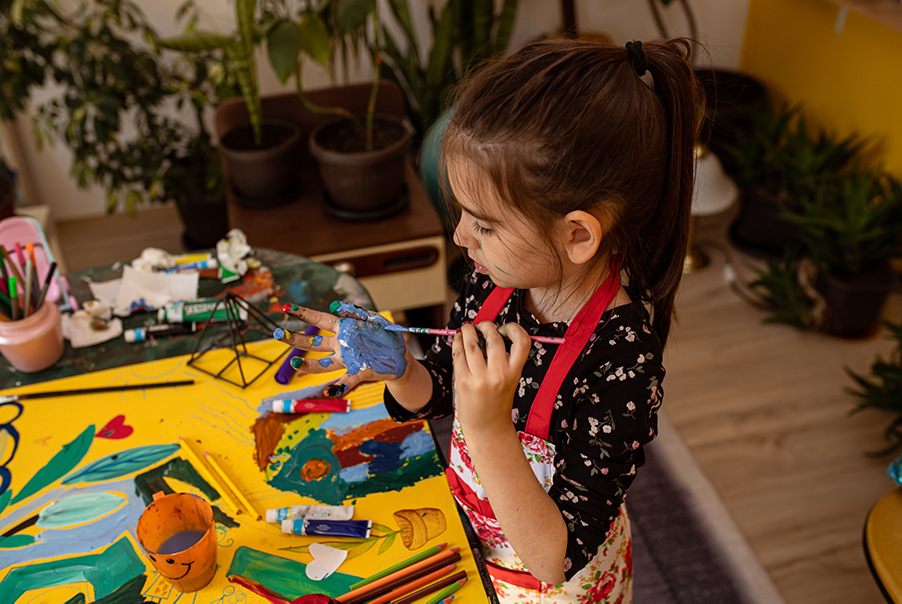Money Saving 301
Save on After School Arts and Crafts for Kids

If you have young kids who don’t have homework or could use some creative activities to do after school rather than watching TV, here are few simple ideas to try which won’t break the bank.
Paper Cut Art
Paper cutting might seem simple, but its been around for centuries. Paper cut art, also known as paper cutting, is a traditional art form that involves cutting designs or patterns from paper with scissors or a craft knife. Its origins can be traced back thousands of years to ancient Chinese and Jewish cultures, where paper was a valuable and accessible medium for artistic expression. Throughout history, paper cutting has evolved and spread to various cultures worldwide, each adding its unique techniques and styles. Paper cutting artists today explore a wide range of techniques, from delicate, intricate designs to bold, abstract compositions.
What You Need: Construction paper, safety scissors, hole punch, and tape or glue stick.
How To: Let kids fold, cut, and decorate paper.
Also Try: Snowflakes, origami, paper hats, boats, sculptures, mobiles, fans, collage, paper dolls, pop-ups, flaps, etc.
Toothpick Sculptures
Nowadays, gluing together toothpicks might seem like a child’s activity but toothpick sculptures can be works of art. They’re created by assembling toothpicks into elaborate structures and forms. The origins of toothpick sculptures can be traced back to ancient civilizations, where artists used toothpicks or similar materials to craft miniature sculptures for religious or decorative purposes. Toothpick sculptures continue to evolve with modern technology, as artists and hobbyists incorporate 3D printing and digital design tools into their process, but we promise it doesn’t need to be that complicated.
What You Need: Toothpicks and glue, tape, or marshmallows (stale works best)
How-To: Let kids build sculptures using the materials described.
Also Try: Pipe cleaners, straws and tape, play dough and tools, cardboard boxes and glue, bread dough and raisins.
Crayon-Watercolor Resist
Kids love coloring with crayons and it seems like we all have boxes of them laying around. Crayon-watercolor resist is a popular art technique that involves using crayons to create designs on paper and then applying watercolor paint over them. Many students have tried the technique in art class at school. The wax in the crayons resists the watercolor, creating a beautiful effect where the colors repel each other. The origins of this technique can be traced back to the early 20th century when artists began experimenting with different ways to combine wax and water-based paints. The technique is particularly popular among children and art educators as it encourages creativity and experimentation.
What You Need: Watercolor paper and crayons
How-To: Let kids draw for a while then bring out the watercolors to paint over the drawing.
Also Try: Oil pastels. Draw white on white then reveal the mystery drawing by painting over it. Paint over leaf crayon rubbings.
Masking Tape Art
Masking tape art, also known as tape art or tape graffiti, is a form of contemporary art that involves using various adhesive tapes, mainly masking tape. The origins of masking tape art can be traced back to the late 20th century when urban street artists began exploring alternative mediums. Some notable techniques include layering tape to create depth and dimension, as well as using tape to mask areas for painting or other artistic applications. Masking tape art lets kids get creative with colors and sticky stuff, what’s not to love?
What You Need: Paper, scissors, and masking tape.
How-To: Let kids cut or tear masking tape into pieces and adhere to paper in any way desired.
Also Try: Multiple colors and widths of tape. Draw or paint over the masking tape art then remove the tape.
Q-tip Pointillism
Q-tip pointillism combines the principles of pointillism with the use of Q-tips and masking tape to create intricate designs and vibrant compositions. The origins of masking Q-tip pointillism art can be traced back to traditional pointillist techniques, where artists use small dots of color to form larger images. Georges Seurat founded pointillism in the late 19th century. You may recognize his famous piece, “A Sunday on La Grande Jatte,” where people are leisurely enjoying a sunny afternoon on the banks of Seine River near Paris. This art form has gained popularity among parents and children alike as a fun and educational activity that promotes fine motor skills and creativity.
What You Need: Paint, paper, and Q-tips
How-To: Let kids dip Q-tips in paint then press on paper to make a picture with dots.
Also Try: Cotton balls for larger dots. Use Do-A-Dot markers or regular markers. Try two primary colors together to see if you can create the illusion of color mixing.
We hope you enjoy some of these after school activities! Try getting creative using items you may already have around the house. Whatever your approach, a little extra thought and planning can go a long way to have fun and save some cash.
Arts and Craft FAQs
What are some good arts and crafts for kids?
There are many ideas in addition to the ones mentioned above. Some fund arts and crafts that kids enjoy include making slime, playing with kinetic sand, bubble painting, building cardboard buildings, combining rice and food coloring to create rainbow rice, creating fairy gardens, creating pipe cleaner crafts, popsicle stick crafts, and so much more!
What is a fun thing to make with kids?
There’s a variety of fun things to make with kids. With baking soda, cornstarch, water, and food coloring you can make homemade clay. Do your kids like dinosaurs? Grad some craft foam, scissors, paint and glue to create dinosaur feet. Instead of buying flower pens, make them with your kids. All you need is silk or plastic flowers, a ballpoint pen, and floral tape.
How do you teach kids arts and crafts?
Start by setting up a designated space with supplies like pencils, paper, markers, crayons, scissors, glue, and various crafting materials. Encourage exploration and experimentation by providing a variety of activities suited to different ages and interests. For younger children, simple projects like finger painting, collage making, or playdough sculpting can be engaging and fun. Older kids may enjoy more complex activities such as origami, jewelry making, or painting. Don’t forget to praise the children’s efforts and display their artwork proudly!
Editorial Policy: The information contained in Check `n Go’s Finance Academy Learning Center is for educational purposes only and is not legal advice. You should consult your own attorney or seek specific advice from a legal professional regarding any legal issues. Check `n Go does not act as a credit counseling, repair service, or debt consolidation service in providing this content. Please understand that Check `n Go policies change over time. Blog posts reflect Check `n Go policy at the time of writing. While maintained for your information, archived posts may not reflect current Check `n Go policy.
The information contained in our blog posts are the author’s own opinions, not those of Check `n Go or any other company. Any pros and cons are developed by our editorial team based on independent research. Some of the products, services, and offers on this page may not be available from Check `n Go. In Texas only: Check `n Go does not act as a credit services organization in providing this content.



